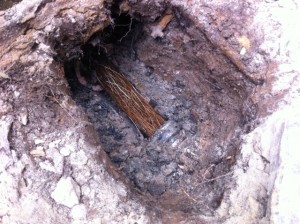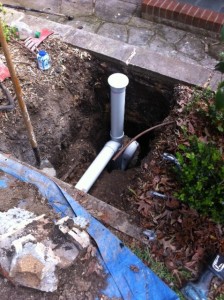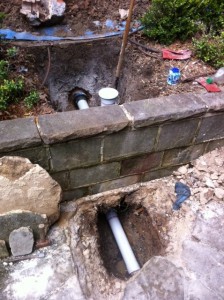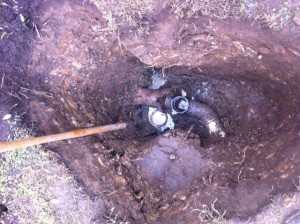OUR LOCAL TURRAMURRA PLUMBING BUSINESS IS READY TO ATTEND YOUR PROPERTY TO CLEAR ALL BLOCKED DRAINS. WE COVER ALL OF SYDNEY AND OFFER QUALITY SERVICE. OUR PLUMBERS ARE READY TO DEAL WITH YOUR BLOCKED DRAINS AT ANY TIME OF THE DAY. FOR SERVICE CALL DAVE NOW ON 0422465381. FOR MORE HELP AND INFORMATION ON BLOCKED DRAINS PLEASE READ ON. WE HAVE INCLUDED SOME TIPS AND TRICKS ON FIXING BLOCKED DRAINAGE.
Blocked drains or overflowing gullies are caused by an obstruction in the pipes. We use the latest technology to clear your blocked drain fast and efficiently using a water jetter. The water jetter uses high pressure water with specially designed nozzles to cut through and remove the blockage. CALL DAVE ON 0422465381 FOR SERVICE.
We also have a drain camera to allow us to determine what caused the obstruction and assess the condition of your pipe work. We also are able to pin point locate fault sections of pipe work so they can be repaired. Many plumbers don’t have this technology and spend wasted time digging around trying to find the pipe but not us. We use the latest in technology to save time and ultimately your money.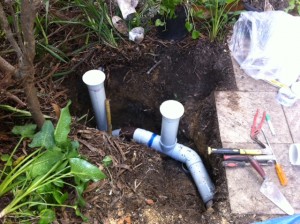
Repairing any drain faults is a must to ensure trouble free drainage in the future. A permanent fix is better than a temporary repair. When repairing drains there are a number of options. We carry out pipe relining which is basically sending a sleeve down the pipeline and inflating another pipe inside. This is a very effective solution depending on the situation. Although costly it means the amount of digging and re landscaping is greatly reduced.
Digging up pipe work and replacing a section of pipe is the most common method of repair. Although sometimes digging up the pipe work is not cost effective and possible.
Blocked sink drains and shower drains are often caused by a build up of grease and hair. Depending on the situation several different ways of clearing the blockage are available. No matter what the situation our Sydney plumbers will be able to fix the blocked drain.
Blocked drain in Pymble.
Helen first noticed she has a blocked toilet when she heard gurgling noises after she flushed. The toilet water got away and went down but only after about 10 mins. Eventually it blocked altogether and the bowl was full of sewerage.
Helen called Drain and plumb to fix her blocked pipe. The plumber to the Pymble house and was greeted by Helen. The toilet was the only fixture blocked so the blockage was determined to be close to the toilet. There was no access into the toilet line so the plumber had to carry out a small excavation to gain access into the sewer pipe.
Once the pipe was exposed the plumber set up the water jetter and sent it down the drain to remove a root and debris blockage. The line was tested and flowed well. The plumber then repaired and raised the sewer pipe to they would have access next time they had a blocked drain. Helen learnt that this will save her time and money if the problem reoccurred.
Helen was impressed with the service and knowledge of the plumber. She has other rental properties in Turramurra, Wahroonga and Hornsby that also have blocked drains from time to time.
An overflowing drain at back of house
Richard from Turramurra called Drain and plumb on Sunday to book an appointment to fix his sewer. The problem was that his sewerage was overflowing from the gully at the rear of his property.
The plumber attended the job with the high pressure water jetter to clean and clear the sewer system. Richard directed the plumber to the back of the property. The water jetter was sent down from the gully drain to clear tree roots from the line at two points.
Unfortunately the jetter became stuck in the drain. A camera inspection revealed that the drain was badly damaged by tree roots and required immediate repair. The camera and locator were used to pin point the drain fault location. The plumber provided a budget estimation of the work and price required to fix the fault. The excavation began and the pipework was repaired. Care was taken not to disturb any plants or grass. A protective sheet was placed to take all soli from the excavation.
The water jet equipment was retrieved and used to clean up the overflow from the blocked drain and then packed back into the truck. The invoice was issued on site and transaction completed. Richard was happy to have the problem fixed so quickly and said he would recommend Drain and plumb to all his friends in Turramurra and Wahroonga.
Storm water running under house
Ben noticed that after heavy rain there was water pooling under his house in Pymble. One phone call to Drain and plumb in Turramurra and an appointment was organised.
Upon inspection of the house stormwater drainage it revealed that two ground drain lines were blocked. The drain clearing water jetter was sent down the pipes. Both lines were cleared of debris and water now flows freely to the kerb side. The cause of the lines blocking up were due to the drains being under sized. A budget estimation was supplied to replace the current drainage. The estimation was accepted and work began.
The drain pipes were replaced all the way to the street kerb side. Grates were put at ground level to help protect leaves and rubbish entering the drainage system. Since Sydney has many large trees a lot of leaves and debris fall and eventually cause blockages. The Sydney plumber suggested to Ben to clean out the area around the grates and keep the guttering free of debris.
Ben also required some taps and toilets to be fixed. A leaking toilet can waste a lot of water. Ben’s toilet was a Caroma toilet suite and was only 5 year’s old.All washers and even the inlet valve was changed to provide a full service. Toilets require maintenance just like everything else. The toilet was then tested.
The next job was to fix the taps in the laundry. Upon inspection the taps were dripping badly and required a full service. The taps were dismantled and all washers changed and tap body lubricated. The tap seat was grinded to provide a smooth face for the washer to seal to. This type of job is very common for all Sydney plumbers.
Ben was pleased to have all issues fixed and now knows he’s not wasting any more money on dripping taps and toilets. Ben was glad to have found a local Sydney plumber who could fix his blocked drain and taps on the same visit.
Surcharging drain
Phillip from Wahroonga was pumping some water out of his pool after the heavy rainfall when he noticed his lawn become flooded. Phillip called Drain and plumb to come and have a look.
Upon arrival the plumber noticed a white cap or lid on the lawn. This lid was part of the sewer system which has blown off due to the drain overflowing. The drain was blocked and required water jetting. The water jetter was sent down the drain to clear tree roots from the line. Phillip then pumped out the pool to test the line. The sewer is now running well.
Sometimes blocked drains can occur at inconvenient times but this time Phillip was lucky. Phillip was delighted with the service and has recommended the plumber to his friends in Roseville, Lindfield, Gordon and Killara
We Specialise in blocked drains, emergency plumbing sydney, blocked drains sydney, tree roots in drains, tree roots , blocking drains, blocked drains Turramurra, blocked drains St Ives and surronding areas, blocked drains in Gordon, blocked drains Killara, blocked drains Roseville, blocked drains Pymble, drain unblocking, clear drains, plumber, plumber Sydney, emergency plumber, blocked drains Chatswood, blocked drains Mosman, blocked drains Wahroonga.
How to fix a blocked drain?
The householder is responsible for the whole drainage system up to where it joins the boards sewer. In Sydney the boards sewer or sewer network is owned and maintained by Sydney Water. Sydney Water is responsible for cleansing any part of a communal system. The network of sewer lines in Sydney is very extensive and many blockages occur due to old sewer lines with tree roots and drain faults.
When assessing your blocked drain take precautions in protecting yourself from the raw sewerage. Too save time and ultimately money it is always good to note which fixtures or drains are are affected by the blockage.
Inspection chambers or manholes should exist at every point where pipes join and where the direction or gradient of the drain changes. Most houses will have inspection lids which look like white caps if they have plastic PVC drainage. They range from around 100mm in diameter to 150mm. They are installed to provide an access as well as a viewing point to your sewer line.
Waste from the WC is fed directly into a pipe of a larger diameter – soil stack, leading to the underground drains. The drain gases are discharged at a safe height into the open air above the house guttering.
The waste pipes from your plumbing fittings leading from upstairs baths and washbasins reach the waste stack directly, via a hopper funnelling the water into another vertical pipe.
An unpleasant smell from the inspection chamber is usually the first sign of a blocked drain. Sometimes if the blockage is severe, sewage can overflow from a gully or from under the cover of an inspection chamber.
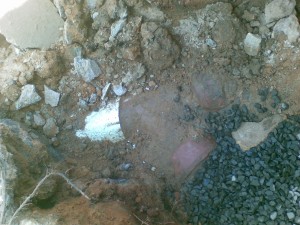
Rod from Wahroonga
Rod called us on Sunday evening because he had noticed that his toilet at the back of the property was not flushing properly. The toilet bowl was filling with water after flushing and would take nearly 30mins to go down to the normal level. We attended the property and spoke with Rod to gain as much information on the problem as we could. Rod showed us where the previous plumber has installed two inspection shafts. The inspection shafts allow access to the sewer line. The drain camera was pushed down the line to inspect the inside of the pipes. The inspection allowed us to pin point the problem and provided Rod with a view of the drain condition. We found tree roots entering the old clay pipes in several points. The tree roots were the cause of the blocked drain. The water jetter was used in conjunction with the drain camera to cut out the tree roots. Once the jetting was complete we checked our work with the camera. The sewer line is now clear of tree roots and the toilet now flushes freely.
Rod also mentioned that his storm water line at the front of the property was also slow to drain. Upon using the camera to inspect the drain we found it also has been infested with tree roots. The water jetter was used to unblocked the drain. The line now flows to the kerbside without any blockages. Rod was very pleased that the camera was used to show him what was going on and to cut out any time wastage and guess work.
Rod said that he will use Drain and plumb for future works as he was impressed by the great customer service and plumber knowledge. Its always good to have a local plumber to Wahroonga Sydney.
A blocked toilet in St Ives Sydney
Audrey called Dave from Drain and plumb to fix a leak in the ensuite toilet. Dave who is a Sydney plumber investigated and found that the toilet required a new inlet valve and also to replace the outlet washer. A new inlet calve was installed and the correct water level set. The outlet washer which seals the water after flushing had also perished and was changed.
When the toilet was being flushed to test the new valve and washer operation Dave the Sydney blocked drain plumber noticed that the water level inside the pan began to rise indicating a blocked drain. Dave informed the client of the blocked toilet. The toilet had never blocked before and there was no point of access available for the water jetting drain cleaning machine. A drain camera was sent down the hand basin drainage line to locate where the sewer line ran through the outside wall and into the mai
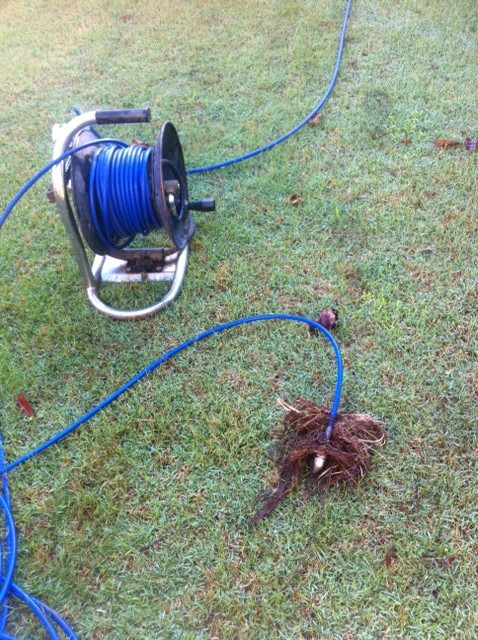 n line. Usually there is an inspection piece located immediately as a pipe exits a wall. The line was located in Audrey’s garden bed underneath a small tree.
n line. Usually there is an inspection piece located immediately as a pipe exits a wall. The line was located in Audrey’s garden bed underneath a small tree.
The pipe inspection opening was found approximately 400mm beneath ground level. The inspection lid was removed and sewerage surcharged from the opening. This indicated that the blockage was downstream further. The water jetter was sent down the drain to clear tree roots at only 1 to 2 meters down.
WE COVER ALL OF SYDNEY AND OFFER QUALITY SERVICE. OUR PLUMBERS ARE READY TO DEAL WITH YOUR BLOCKED DRAINS AT ANY TIME OF THE DAY. FOR SERVICE CALL DAVE NOW ON 0422465381
A Sydney plumber is a tradesperson who specializes in installing and maintaining systems used for drinking. Plumbers also maintain water, sewage, and drainage in plumbing systems. The word PLUMBER is related to the Latin word for lead or “plumbum.”
Water leaking under house in St ives
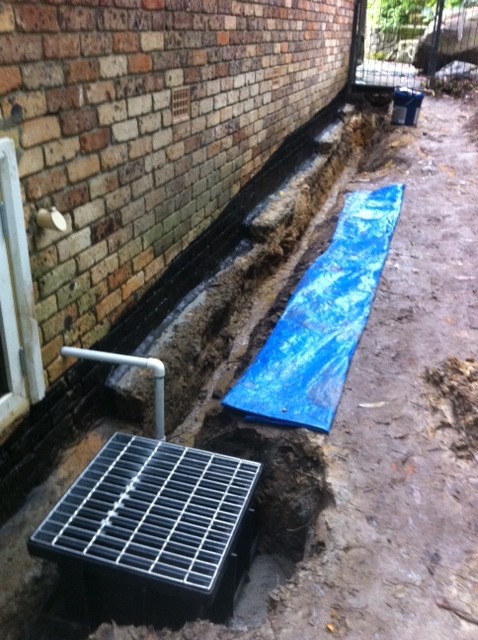 Geoff from Stives called to report that he was getting water travelling under his house after heavy rainfall. Dave who is a Sydney Plumber from Turramurra attended the site. The house is located in St ives Chase and is on the side of a steep hill. The house foundations have been cut into the sandstone hill. After assessing the job it was decided that a subsoil and surface drainage system was needed. The wall and footings required re sealing and patching. The water was clearly travelling above and below the ground and penetrating the house wall. Work started two days after the first visit. Dave took several photos of the site to show what was involved to stop water travelling under the house.
Geoff from Stives called to report that he was getting water travelling under his house after heavy rainfall. Dave who is a Sydney Plumber from Turramurra attended the site. The house is located in St ives Chase and is on the side of a steep hill. The house foundations have been cut into the sandstone hill. After assessing the job it was decided that a subsoil and surface drainage system was needed. The wall and footings required re sealing and patching. The water was clearly travelling above and below the ground and penetrating the house wall. Work started two days after the first visit. Dave took several photos of the site to show what was involved to stop water travelling under the house.
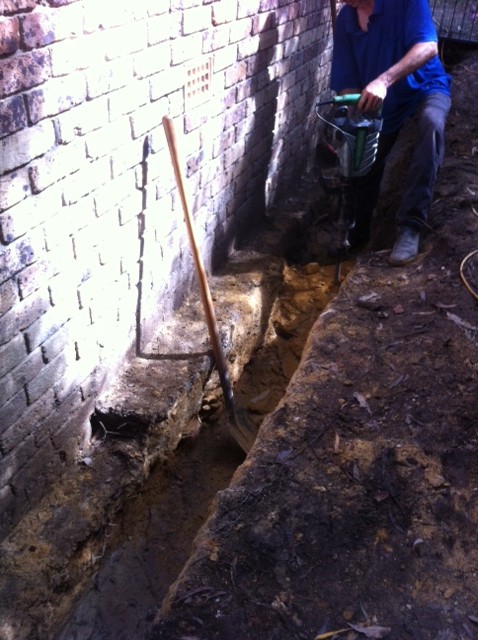
A flooding garage in Pymble Sydney
Ken from Pymble called to report that he had a blocked stormwater drain which was outside his front door. The drain was blocked and the water was running out of the drain and through his garage. The water jet was sent down the drain to remove tree roots from the line. The jetter was sent down to clean the drain out to the kerbside.
The rain was still pouring down and the drain was now flowing well to the street. Ken showed me a channel grate drain he had at the back of the garage. It was suggested to install a pit to catch water run off from the back yard. A 300mm by 300mm stormwater drain pit was installed. See the photo next to this article to see the finished job. Drain and plumb took care of the whole job including the concreting of the path and paving. All rubbish was removed from site and the site was left tidy and clean.
Blocked Drains
Virtually everyone has faced a blocked drain in Sydney. This situation can be very annoying because it tends to happen at the most embarrassing moments. Whether it is a toilet, a bathroom sink, a shower or tub or a kitchen sink that has a clogged drain, consider the following information about this vexing problem:
General Information Regarding Drainpipes
Drainpipes move wastewater away from the bathroom and kitchen fixtures in the house to the sewer, septic tank or cesspool. Drainpipes are larger than water pipes, ranging in diameter from 1¼ to 4 inches. Common drainpipe materials are galvanized steel, copper, cast iron and plastic.
Galvanized steel was used throughout the 1940s, and a fair amount of copper and brass drainpipe systems was used in the 1950s and 1960s. After the mid-1970s, drainpipe systems tended to be either acrylonitrile-butadiene-styrene (ABS) or white polyvinyl chloride (PVC).
Types of Blocked Drains in Sydney
There are two kinds of blocked drainpipes:
• Localized obstruction. This type of blockage usually occurs in a fixture trap in a mechanical waste fixture, or at a sudden change in the direction of piping. This kind of clog is the one most often shown in chemical drainpipe cleaning advertisements.A localized obstruction is generally the result of a buildup of soap, hair and cosmetics, or the presence of foreign objects, like toothpicks, cotton swabs, tissue or small toys.A localized obstruction is fairly easy clear. The obstruction can be forced out with a plunger, be retrieved using an inexpensive auger (snake pipe) or a straightened wire coat hanger.
• Extended accumulation. This type of clog takes years to form, and only high pressure water jetting or a power-driven, blade-head auger can effectively remove this kind of clogged drain.Enzymatic cleaners could alleviate an extended accumulation clog, but nothing is as thorough as high pressure water jetting or an auger. The removal of an extended accumulation clog requires the hiring of a professional drain plumber.
Recognizing a Blocked Drain in Sydney. Some signs that indicate a blocked drainpipe are:
• Unpleasant smells from bath or kitchen drainpipes
• A bubbling sound coming from the toilet when water is being used
• Toilet water level rises above the rim or drops below normal levels
• Shower drains too slowly
• Outside areas are wet with smelly, stagnant water
• Plants and trees have died because the ground is too wet
Fixing Blocked Drains in Sydney
There are fairly simple solutions to fixing blocked drains. Most clogged sink, shower and bathtub drainpipes result from the build up of soap scum, hair and oil. Toilet blockages can occur from too much toilet paper or sewage being flushed at one time. Plus the odor associated with certain types of blocked drainpipes can also be extremely unpleasant. Here are some solutions to fixing a blocked drainpipe:
1. Use of Chemical Drainpipe Cleaners
There are three kinds of chemically-based drainpipe cleaners: alkaline, enzymatic and acidic.
• Alkaline Cleaners. These alkali-based products can be found at the supermarket. They are poured directly into a clogged sink or tub drainpipe. Alkaline cleaners have copper sulfide, sodium hydroxide or sodium hypochloride as their active ingredients. They dissolve simple hair and grease clogs, but they are useless to clear an extended accumulation.
• Enzymatic Cleaners.These products are less hazardous to humans and are more environmentally friendly because they use enzymes to alleviate a clogged drain. Enzymatic treatments work, but they take a few days. They should be used for preventative maintenance. Using an enzymatic treatment twice a year will help keep drainpipes clear and will benefit a septic tank system if the house is not connected to a sewer system.
• Acidic Cleaners. Acids are dangerous. They are effective, but they are extremely harmful in the wrong hands.Sulfuric and hydrochloric acid will dissolve almost any blockage commonly found in blocked drain systems in Sydney, like dish rags, diapers, tampons, chicken bones and the like. However, hydrochloric acid will also damage porcelain, most metals and most anything except vitreous china.
Sulfuric acid is less likely to damage metal piping but will degrade aluminum, stainless steel and porcelain. Further, sulfuric acid’s rotten-egg smell is unbearable.Acidic cleaners should be used as the last resort to fixing a blocked drainpipe in Sydney. Avoid using them if possible.
2. Use of Mechanical Drainpipe Cleaners
• PlungerA plunger that has a foldout extension cup is the best kind to use. When the plunger is folded in, it works on sinks, showers and tub drains. When it is folded out, the plunger fits a toilet outlet. Standard plungers have trouble making a seal in toilets, and without a good seal, plunging is not effective.
• Water Jetting. Water jetting by a professional drain plumber is a highly effective and eco-friendly method of clearing blocked drains in Sydney. Over time, deposits such as grease, dirt and minerals accumulate along the walls of drainpipes, constricting water flow.Water jetting uses a high pressure water jet that acts like a sharp knife that cuts the extended accumulations off the pipe walls. The water used in water jetting flushes the accumulations down the line.
Water jetting clears blocked drains without the use of corrosive chemicals that can damage drainpipes and the environment. Further, water jetting can clear clogged drains without the need to dig up sections of drainpipe. Water jetting can also be used to remove roots that have reached into the sewer drains by using special cutting devices that are powered by the water jet. Water jetting will not cut the drainpipe due to the constant movement of the water jet, the inside surface of the drainpipe and the angle of the jet.
Note that water jetting equipment used for indoor plumbing is different than water jetting equipment used for outdoor plumbing. Water jetting equipment has not been priced for homeowners and should not be rented by people who are not familiar with operating such equipment. Water jetting is a job best suited for a professional plumber.
• Auger or Snake. Like a water jet, an auger or snake can be used to remove stubborn extended accumulations. An auger is a long, coiled cable with a spring head on its working end. An auger can be used to clear most clogged drains, but it is not effective on grease clogs, which tend to reseal when the auger is removed from the pipe. Moreover, careless or vigorous use of an auger can result in damage to pipe bends, traps and gullies. Therefore, water jetting is generally the better method of clearing blocked drains and is best performed by a professional plumber.
Clearing Bathtub Drainpipes
Most tubs will empty slowly because the line or trap is clogged due to hair clinging to the trip waste linkage. A crooked trip waste linkage will also cause a tub to empty slowly. Do not assume there is a blocked drain line until the trip waste linkage is inspected.
The best way to snake a clogged drainpipe is through the overflow tube. This is because the piping connection is not under the tub’s drain fitting, but 6 inches forward, under the overflow tube. Cabling the opening will result in hitting the T-fitting immediately. It may be prudent to simply consult a professional plumber.
Clearing Shower Drainpipes
Shower drainpipes clog because hair catches on the drain screen or a ragged pipe or fitting edge. Remove the screen and shine a flashlight into the drain pipe. If there is a clog, pull it out and see what caused it. If possible, file down any sharp edges that may have caused the clog. If no clog is visible, then insert an auger cable and clear the entire drain line, or better yet, hire a professional plumber.
Clearing Toilet Drainpipes
If the toilet is about to overflow, quickly remove the tank lid and lift the float. If the water is up to the rim, close the flapper and lift the float. In a few seconds, the water in the bowl will recede enough to lower the float. Turning off the shutoff valve is another alternative, but that might take too long.
• Plunger
First use a plunger to clear a clogged toilet drainpipe. Fold the extension cup out and pump the plunger vigorously until the water level drops. Flush the toilet to see if the obstruction has been forced out, while remaining ready to lift the float if necessary.
• Auger
If a plunger will not clear the clogged drain, then resort to an auger cable. Pull the handle and cable back, insert the bend of the tube into the outlet. Slowly push the cable forward while cranking in a clockwise direction. When the crank handle bottoms out, retrieve the cable and repeat the process. Run the cable through at least three times, forcing it left, right and center.
If this method does not work, empty the bowl with a paper cup and hold a pocket mirror in the outlet. Shine a flashlight into the mirror so it illuminates the top of the trap. The obstruction should be revealed. Bend some wire into a hook and pull out the obstruction. If the obstruction is not visible, then consult with a professional drain plumber.
Access to Sink Lines
The most difficult part of cleaning a sink drainpipe is gaining access to the sink line. Snaking directly through the sink drainpipe almost never works because they are designed to keep things out. Any snake with a large enough head that will force out the obstruction will not fit through the openings. Even if the snake did fit, however, the operator would be working against the resistance of a fixture trap. Moreover, if the clog is in the trap, it would probably be best to use a plunger or take the trap apart.
This particular situation could result in much angst for the homeowner. Therefore, it might be best to just call a professional drain plumber.
Access to Cleanout Fittings
The removal of a cleanout plug in a home where the drainage piping system is made of cast iron will require effort. Once again, the homeowner may be better off hiring a professional drain plumber.
Clearing Sewer Lines
Clearing the underground sewer line between a house and the street is complicated. It is not job for homeowners who are not professional drain plumbers.
Water Jetting
Water jetting sewer lines requires a certain amount of water pressure to clear the obstruction. Water jetting a kitchen drainpipe would require water pressure of 1,500 pounds per square inch (psi). Larger drainpipes with serious obstructions may require water pressure of 4,000 psi or more. Also, the amount of water pressure must be considered in light of the type of piping material. Excessive water pressure could damage the pipe.
Auger
A power-driven auger is big and strong, and the motor is always stronger than the cable. To prevent breaking the cable off inside the sewer line, the operator must listen carefully to the motor and feel the resistance of the cable. The operator must be able to sense the difference between tree roots, a broken pipe, piping offsets and the juncture of the private sewer service and the public sewer main.
Repelling Tree Roots
Copper sulfate-based cleaners are the most effective at keeping tree roots out of sewer lines. Copper repels roots; therefore, a once or twice a year treatment is a good idea in Australia, where tree roots are a common cause of blocked drains. It is interesting to note that old-time plumbers wrapped copper wire around sewer pipe joints.
Hot Water Drainpipe Maintenance
Blocked drains caused by extended accumulation clogs generally occur in the kitchen and bath lines because in homes where the homeowners are conservative of water, the drainpipes do not receive a good purge of the build up of grease, hair, soap and food particles. To avoid extended accumulation clogs, the hottest tap water should be run from every fixture, with the stopper closed, every two weeks. When the sink or tub is nearly full, the
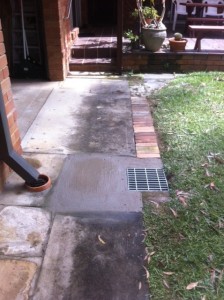 stopper should be opened, followed by 30 seconds of hot tap water.
stopper should be opened, followed by 30 seconds of hot tap water.
The Importance of Wastewater Drains
Every major civilization has had to contend with the problem of developing and maintaining effective wastewater drainage systems.Early drainage systems built for the disposal of human wastes were primitive and not effective in disposing human wastes. Human waste was often transported from the cities in carts or buckets or discharged into an open, water-filled system of ditches that led from the city to a lake or stream.
Improvement in drainage systems was very slow. Hardly any progress was made from the time of the Roman civilization until the 19th century. Sanitation facilities were inadequate to keep up with the demand of large, crowded population centers that sprang up during the Industrial Revolution. Outbreaks of typhoid fever and dysentery occurred as a result of people consuming water contaminated with human wastes.
Eventually these epidemics subsided after the development of separate, underground sewage systems, which eliminated open sewage ditches. In addition, indoor drainage systems and plumbing fixtures were designed to handle the disposal of wastewater.
Wastewater Drainpipe Materials used in Sydney
Cast Iron
Cast iron is the strongest material for drains. Cast iron’s heavy weight helps contain noise.
Copper
Copper is mostly used for water supply lines, but it does come in larger pipe sizes. Copper is costly, however, and is seldom used in Sydney for new installations of drains in Sydney buildings.
Polyvinyl Chloride (PVC)
PVC is a rigid plastic pipe material. PVC is a good material for drains; it is lightweight, easy to install, corrosion resistant and inexpensive in Sydney.
Wastewater Drainage Systems in Sydney
Drainpipes carry wastewater away from the plumbing fixtures to vertical stacks. These drains lead to the house’s main drain, which connects to a sewer line. Cleanouts in both the stacks and main drain provide access for unclogging the drain system. Unclogging the main drain or the vertical stacks is a job best suited for a professional plumber.
Gravity and Waste
To ensure a smooth flow, drainpipes lead away from fixtures and appliances at a carefully calculated slope. If the slope is too steep, water runs off too fast, leaving solids behind. If the slope is not steep enough, the drain empties too slowly and water backs up into the fixtures. The normal slope or pitch is ¼ inch for every horizontal foot of drainpipe. Consult a professional plumber to determine whether the source of a blocked drainpipe may be the result of improper pitch.
Anatomy of a Wastewater Drainage System in Sydney
The in-house waste drainage system starts with a main pipe several feet outside an exterior wall, which passes under the house footing and into the basement or crawlspace. This below-floor drainpipe, usually 4 inches in diameter, is called the main soil pipe.
The main soil pipe continues horizontally under the basement floor or slab (or along a wall), sometimes branching off and reducing to serve a laundry standpipe, maybe a floor drain and possibly a basement bathroom and kitchen riser. The main soil pipe runs under the basement floor, where it terminates in a 90-degree sweep bend through the floor and becomes the base for the primary vertical stack, or the main stack.
Smaller drain stacks also come off the main soil pipe and continue upward. These secondary drain and vent stacks may tie into the main stack above the highest fixture or pass through the roof independently.Every home in Sydney should have a full-size (3 or 4 inch diameter) stack that travels from the soil pipe to roughly 12 inches above the point of exit through the roof.Think of this main stack as the trunk of a tree. At each floor, horizontal branch lines reach out to serve individual fixtures or fixture groups.
It may be wise to seek the advice of a professional plumber to ensure that your home’s wastewater drainage system is efficiently designed and properly installed.
Cleanouts and Sanitary Fixture Traps Used in Wastewater Drains in Sydney
Cleanouts are placed in drains to provide access for removing clogs. Ideally, there should be one cleanout in each horizontal section of drainpipe, plus a U-shaped sanitary fixture trap (sometimes located outdoors) for the main house drain.A cleanout is usually a 45-degree Y-fitting or a 90-degree T-fitting with a removable cap on one end. Sanitary fixture traps, or a U-bends, provide a water seal between the sewer drains and the rooms in which plumbing fixtures are installed. This trap is installed in the drainpipe adjacent to the outlet of each fixture. A portion of the waste water discharged by the fixture is retained in the U, forming a seal that separates the fixture from the open drains. Removal of cleanouts and taking traps apart to clear obstructions can require much effort for the homeowner. It might be easier to hire a professional plumber.
Vent Pipes
Vent pipes are important to a wastewater drainage system because they allow traps and drains to function properly. When water flows from a fixture through a pipe, it displaces an amount of air equal to its own volume, creating negative pressure behind the flow. This localized suction can be strong, especially at the bends in of a pipe. A toilet flushing near a sink can easily pull water from the sink’s trap, allowing poisonous sewer gas to enter the living quarters. In fact, without adequate venting, a toilet will not flush properly.
Every home in Sydney needs a stack vent through the roof. Auxiliary vents may be necessary, and their shape, size and location are critically important. It is best to hire a professional plumber to inspect and repair the vent system if sewer gases can be detected inside the home.
Hire a Professional Plumber in Sydney
People are often blissfully ignorant of drainage systems until a bath or kitchen fixture is clogged and wastewater backs up. To save money, homeowners feel that they can make the repairs themselves rather than hire a professional plumber. However, note that plumbing is messy, dirty and must be done right. It can take much sweat and stamina to pull off a major job. Even simple repairs under a sink may require a lot of patience and physical flexibility if there is no easy access.
Do not take your drainage system for granted. If you are at all unsure about your abilities on a given project, you should consider hiring a professional plumber. Further, some plumbing codes require a licensed plumber to perform certain types of work.
\We service the following areas
Allambie Heights blocked drains
Arndell Park
Artarmon clogged drains
Asquith drain blocked
Auburn
Bankstown
Balgowlah Heights blocked pipes
Baulkham Hills
Beacon Hill slow drains
Beaumont Hills
Beecroft blocked toliets
Bella Vista
Belrose blocked sinks
Berala
Blacktown
Cammery gurlging sinks unblocked
Canada Bay
Carlingford blocked sewer
Carramar
Castle Cove sewer blockages fixed
Castlecrag blocked drain plumber
Castle Hill
Central Coast
Chatswood clogged pipes
Chatswood West blocked pipe
Cheltenham
Cherrybrook blocked drainage
Chester Hill
Concord
Cremorne blocked kitchen sink
Davidson
Denistone
Doonside
Duffys Forest
Dundas
Eastern Creek
East Killara overflowing drain
East Ryde
Eastwood
Epping
Ermington
Fairfield
Fairfield West
Forestville
Frenchs Forest hot water heater
Girraween
Gladesville
Glenhaven
Glenwood
Gordon blocked drains
Granville
Greenwich
Greystanes
Guildford
Harris Park
Homebush
Homebush Bay
Hornsby drains blocked
Hunters Hill
Huntingwood
Kellyville
Kellyville Ridge
Killara
Killarney Heights choked drains
Kings Langley
Kings Park
Lalor Park
Lidcombe
Lindfield blocked or slow running toilet
Longueville
Macquarie Park
Manly Vale
Marayong
Marsfield hotwater heater
Meadowbank
Merrylands
Milsons Point blocked kitchen sink drain
Mortlake
Mosman blocked drain over flowing
Naremburn
Northbridge
Northepping
North Haven
Northmead
North Rocks
North Ryde
North Strathfield
North Sydney
North Turramurra blocked sewerage
North Wahroonga blocked stormwater or sewerage
Old Toongabbie
Oxford Falls
Parklea
Parramatta
Pemulwuy
Pendle Hill
Pennant Hills
Prariewood
Prospect
Putney
Pymble blocked drain plumber
Quakers Hill
Regents Park
Rhodes
Rookwood
Rooty Hill
Rosehill blocekd drain
Roseville
Ryde
St Ives blocked drain toilet
St Ives Chase blocked drain cleared
St Leonards
Seaforth
Sefton
Seven Hills
Silverwater
Smithfield
South Turramurra blocked drain
South Wenworthville
Stanhope Gardens
Strathfield
Telopea
Terrey Hills blocked drain
Thornleigh
Toongabbie
Turramurra blocked drain
Villawood
Wahroonga blocked drain
Waitara blocked drain at toliet
Warrawee
Wentworthville
Westleigh
Westmead
West Pennant Hills
West Pymble
West Ryde
Wetherill Park
Willoughby
Winston Hills
Woodcroft
Woodpark
Woolwich
Yennora
